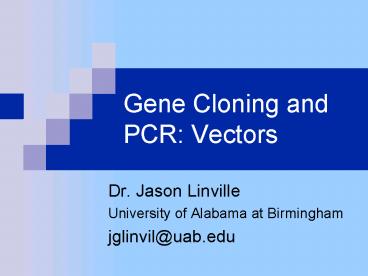Gene Cloning and PCR: Vectors - PowerPoint PPT Presentation
1 / 42
Title:
Gene Cloning and PCR: Vectors
Description:
... Bacteriophages ? ... Lysogenic phages: For bacteriophage M13, phage particles ... Gene Cloning Bacteriophages M13. Genes can be obtained in ... – PowerPoint PPT presentation
Number of Views:1064
Avg rating:3.0/5.0
Title: Gene Cloning and PCR: Vectors
1
Gene Cloning and PCR Vectors
- Dr. Jason Linville
- University of Alabama at Birmingham
- jglinvil_at_uab.edu
2
History
- Before 1950, experiments suggested DNA was
genetic material. - Early 50s, DNA identified and structure
discovered. - 50s early 60s, genetic code cracked,
transcription and translation described.
However, laboratory techniques to study these
newfangled genes stunk.
3
History
- Early 70s, new methodology of recombinant DNA
technology or genetic engineering developed. - Involved use of gene cloning
Later
- 1985, Kary Mullis thinks up the polymerase chain
reaction (PCR)
4
Gene Cloning
- Fragment of DNA inserted into a vector.
- Result is a chimera or recombinant DNA molecule.
5
Gene Cloning
- Vector carries gene into a host cell (usually
bacteria)
6
Gene Cloning
- Chimera and host cell multiplies, creating many
copies of the gene.
7
Gene Cloning
- Cell divisions create colony (clones) of
identical host cells. - Each cell contains one or more copies of
recombinant DNA molecule
8
Gene Cloning
- Once gene is cloned, information can be gathered
about its structure and expression.
9
Gene Cloning
- If multiple DNA fragments are available, how is
only one isolated?
10
Gene Cloning
- Usually, only one vector will enter a bacteria.
11
Gene Cloning
- Q How is the desired colony identified?
A Different ways we will explore later.
12
Polymerase Chain Reaction
- Like gene cloning, PCR results in the
amplification of a region of DNA.
PCR is not done in living cells
PCR is done in test tubes with isolated DNA
13
Polymerase Chain Reaction
PCR Hood
14
Polymerase Chain Reaction
Thermal Cycler - amplifies DNA
15
Polymerase Chain Reaction
- Mixture of DNA and reagents (DNA polymerase
primers) heated to 95ºC
Heat breaks H-bonds DNA denatures
16
Polymerase Chain Reaction
- Mixture is cooled (50-60ºC), allowing primers to
reanneal to DNA based on primer sequence
17
Polymerase Chain Reaction
- Temperature increased (72-75ºC), allowing DNA
polymerase to attach and begin replication.
18
Polymerase Chain Reaction
Cycle repeated 25-30 times
- Results in double stranded DNA fragments with
primer sequences at their ends.
19
Gene Cloning vs. PCR
Limitations of PCR
- In order to amplify an area, the sequences of the
primer annealing sites must be known. - Limited by length regions gt5 kb are difficult to
amplify.
Gene Cloning is only way of isolating long genes
or unstudied genes.
20
Gene Cloning vs. PCR
PCR only amplifies one area
21
Gene Cloning
Vehicles for Gene Cloning
- In order to clone a gene, it must be transported
into living cell.
Two mechanisms for transport
- Plasmid circular molecule of DNA
- Bacteriophages protein capsule injects DNA
22
Gene Cloning gt Plasmids
Plasmids
- Independent circular DNA in bacteria
23
Gene Cloning gt Plasmids
- Have origin of replication and can use host
cells enzymes to replicate independently.
24
Gene Cloning gt Plasmids
- Or possible to integrate into bacterial
chromosome.
25
Gene Cloning gt Plasmids
Plasmid Size
- lt10 kb useful for cloning natural plasmids can
range up to 250 kb
Copy Number
- Number of plasmids per cell
- Range from 1 - gt50
- Ideally, higher copy number better
26
Gene Cloning gt Plasmids
- Plasmids may contain antibiotic resistance genes.
- Allows for the selection of bacteria that contain
the plasmid.
27
Gene Cloning gt Plasmids
- When grown in antibiotic medium only bacteria
with resistant plasmid will grow.
28
Gene Cloning gt Plasmids
Plasmid Classifications
- Fertility Plasmids promote conjugal transfer of
plasmids - Resistance plasmids contain antibacterial
resistance genes - Col plasmids code for colicins, proteins that
kill other bacteria
29
Gene Cloning gt Plasmids
- Conjugation allows for transfer of plasmid copy.
30
Gene Cloning gt Plasmids
Plasmid Classifications
- Degradive plasmids allow host to metabolize
unusual molecules - Virulence plasmids confer pathogenicity on host
bacteria
31
Gene Cloning gt Bacteriophages
Bacteriophages
M13
?
- Viruses that specifically infect bacteria.
- DNA (or RNA) surounded by protein coat
- Genes code for capsid and replication proteins
32
Gene Cloning gt Bacteriophages gt ?
Bacteriophages (Infection)
- Lytic Cycle rapid infection resulting in lysis
of cell and release of multiple bacteriophages.
33
Gene Cloning gt Bacteriophages gt ?
- Phage attaches to outside of bacterium injects
DNA into cell.
34
Gene Cloning gt Bacteriophages gt ?
- Phage genome replicated with enzymes coded for
by phage genome
35
Gene Cloning gt Bacteriophages gt ?
- Capsid proteins synthesized phage particles
assembled and released.
36
Gene Cloning gt Bacteriophages gt ?
- Lysogenic phages For bacteriophage ?, DNA
integrates in to bacterium genome.
- When released, enters lytic cycle.
37
(No Transcript)
38
- ? has
- sticky ends
39
Gene Cloning gt Bacteriophages gt M13
- Lysogenic phages For bacteriophage M13, phage
particles assembled and released without lysing
cell.
40
(No Transcript)
41
Gene Cloning gt Bacteriophages gt M13
M13 Advantage
- Genes can be obtained in single strand form. This
is very useful when sequencing gene.
42
(No Transcript)































